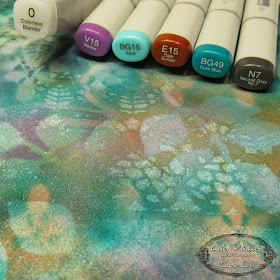You will need to gather some materials to embellish your journal cover: metal, plastics, embellishments, papers, lace, charms, wood, chipboard - whatever you would like to incorporate onto your design. I am using my X-Press It Blending Journal, a variety of lace, Chromacryl white acrylic paint, chipboard shapes from FabScraps and a variety of brass charms and paper flowers.
**Normally it is recommended that you apply your Copics first BEFORE paint, pencil or any other mediums, so they won't become clogged. Before you start, you do need to be aware that when using your Copic Markers on some surfaces you need to understand the nib may become blocked by repeated use over paint and you accept that you will need to periodically replace the nib. It is a good idea to have a few Copics that you use ONLY for mixed media work.**
**Normally it is recommended that you apply your Copics first BEFORE paint, pencil or any other mediums, so they won't become clogged. Before you start, you do need to be aware that when using your Copic Markers on some surfaces you need to understand the nib may become blocked by repeated use over paint and you accept that you will need to periodically replace the nib. It is a good idea to have a few Copics that you use ONLY for mixed media work.**
Paint the journal cover with the white Chromacryl acrylic paint - I used 2 coats allowing each to dry before continuing. Once dry use the fabulous TripleTac glue from X-Press It to adhere your embellishments to the journal cover - allow this to dry thoroughly before continuing.
This is what mine looks like.
Once dry cover everything with white Chromacryl paint and leave to dry. You can add a little texture paste for extra interest at this point if you like.
Spray with your favourite sparkly sprays and let dry (this saves a little Copic ink as it adds a base layer of colour, it also adds a little bit of sparkle to the final project).
Using a Copic airbrush spray BG34 over your cover to colour any light/white areas.
Spray YG25 to about 1/4 of the cover - this can either be randomly or you can choose to colour individual elements.
Still using your airbrush, add V04 to a few places and colour some of the elements eg: flowers or bird - this adds a beautiful contrast to the greens and blues
Add BG49 to darken the colours.
Now this is where things get really interesting! Using the special properties of Copics and the Copic Blender you can achieve some exciting special effects.
Before adding any final colours, use a stencil and the X-Press It Clear Gel Glue to apply a design to some of the areas without embellishment. I also used the Clear Gel Glue to cover some individual elements to highlight them, leave this for several hours or until completely dry.
This results in gorgeous shiny areas (keep reading to see why this is an important step).
Spray BG09 around the edges of the cover - darkening the edges draws your eye to the more colourful area in the centre. Go ahead and use your airbrush to spray right over the top of the glue design.
Add E47 to the edges and to some of the central designs, again this helps draw the eye.
The final colour E49 is only sprayed on to the very edges, and to the central frame - go ahead and spray this well, getting into all the nooks and crannies.
Use the Copic Blender for the next steps - the special effects!
Using the blender brush tip, remove the excess colour from the top of the gel glue elements (make sure to scribble to colour off your blender in between) - this will reveal the original colour underneath which is paler, creating patterns which POP!
Then use the chisel nib to remove colour from the highest points of some of the textured embellishments eg: frame, bird etc, this will reveal the colour underneath and leave yummy darker colour around it (using this flat nib ensures you only touch the very top of the design - resulting in a beautiful colour contrast - just don't press too hard!).
As a final step flick a little of the Copic Various Blending ink onto your project (I add a few drips onto my fingers and just flick this on) - this will add just a little more texture and interest to the final piece.
Once all the colour is dry and you have finished removing colour using the Blender your project will look something like this up close, aren't those colours amazing - the Copic ink even blends and layers over paint!
and this is what my finished journal cover looks like....
Products used on this project:
- Copic Markers: BG09, BG34, BG49, V04, YG25, E47, E49 and Colorless Blender
- Copic Air Compressor
- Copic Colorless Blender Various Ink
- X-Press It: Blending Journal, Clear Gel Glue and TripleTac Glue
- Chromacryl White Acrylic Paint
- FabScraps chipboard shapes, lace, watch parts and other embellishments (metal and acrylic)
- Optional - your favourite sparkly spray as a base - for a matt finish omit this
I just love the amazingly vibrant results achieved with the Copics on this project and the special effects achieved with the Blender make it just that bit more special. I hope this inspires you to have a go at this technique for yourself, I can promise it is loads of fun and the results as you can see are fairly impressive.
I'd love to hear what you think of my journal cover, I'd also love to see how you've decorated your Copic Journal covers so why not post a photo of your decorated X-Press It Blending Journal over on the Copic Australia Facebook page.
Kate






















































